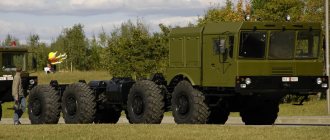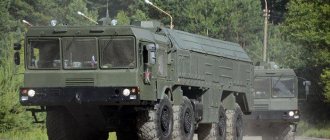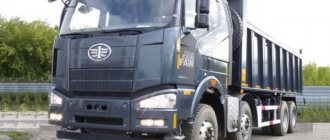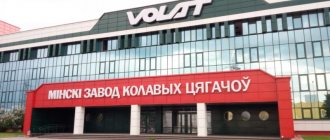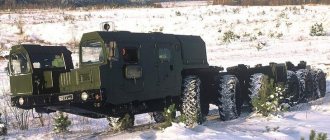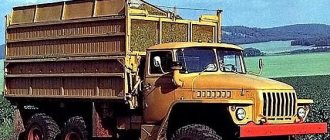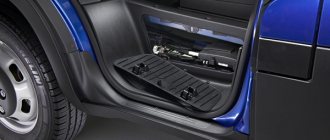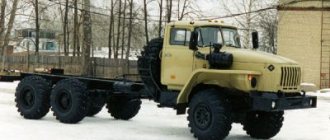Here you will learn:
- Description and characteristics
- Operation of the Zota Topol-M boiler
- Main technical characteristics
- User reviews
The solid fuel boiler Zota Topol-M is a heating unit that uses solid fuel for operation. It was created by one of the domestic developers and is distinguished by its simplicity. The boiler is used to heat buildings for various purposes, from residential buildings to industrial buildings. In this review of this unit, we will talk about its technical characteristics and introduce you to user reviews.
Description and scope of application
MZKT 79221 was released after the collapse of the USSR in 1996-97. Then the chassis was part of the Topol-M mobile installation complex. But serial production of MZKT 79221 began only in 2000. The heavy-duty tractor is used both for military defense purposes and for transporting equipment for civilian purposes (as well as Kamaz-4310).
MZKT 79221 weighs 40 tons. The weight of the vehicle together with the rocket reaches more than 120 tons. The tractor can transport a weight of up to 80 tons off-road. Used as a heavy-duty chassis for transporting equipment for oil wells and heavy-duty cranes. The chassis includes 16 single-wheel wheels. (the first three and the last three) are steerable
Indices of missile systems of the Strategic Missile Forces
DATA FOR 2022 (standard replenishment) Indices of missile systems of the Strategic Missile Forces
| Official name | Type | Western designation | Complex | SPU / APU | Rocket | Rocket is official | Note |
| “Barguzin” | BZHRK | 15Zh83 (source, source) | |||||
| “Perimeter-RC” / “Sirena” | PGRK | 15P175 | 15Yu75 / 15Zh75 (source) | command missile based on the Topol PGRK and 15Zh58 missiles | |||
| RS-26 “Rubezh” | PGRK | KY-26/SS-X-31 | 15U194 (?) | 15Zh67 (source) | 2015 undergoing testing MZKT-79291 (?) | ||
| RS-24 “Yars-M” | OS | 15P165M1 (source) | 15P765M1 (?) | 15Zh65M / 15Zh65M1 / 15Zh80 (source) | 2012 (15Zh65M1)2016 (15Zh80) | ||
| RS-24 “Yars” | OS | SS-29SS-27 mod.3 SICKLE-С / STALIN | 15P165M | 15P765M | 15Zh65M | RS-12M2R | |
| RS-24 “Yars-M” (?) | PGRK | 15P155M1(source) | 15U175M1 | 15Zh55M1 (?) | 2012 | ||
| RS-24 “Yars” / “Topol-MR” | PGRK | SS-29SS-27 mod.2 SICKLE-B / STALIN | 15P155M | 15U175M | 15Zh55M | RS-12M2R | MZKT-79221 |
| "Speed" | PGRK | 15P666 | 15Zh66 | RSS-40 | |||
| "Albatross" | OS | 15P170 | 15P770? | 15Zh70 ? | |||
| RS-12M1 “Topol-M” | PGRK | SS-27 SICKLE-B/STALIN | 15P155 | 15U175 | 15Zh55 | RT-2PM1 | |
| RS-12M2 “Topol-M” | OS | SS-27 SICKLE-B | STALIN | 15P06515P165 | 15P765, 15P765-18, 15P765-18M, 15P765-18E, 15P765-30, 15P765-30P, 15P765-35 | 15Zh65 | RT-2PM2 | originally – Yuzhnoye Design Bureau |
| “Virgin soil” | PGRK | 15P962 | 15P162, 15P662 | 15Zh62 | MIT (source) | ||
| RS-22A “Well done” | BZHRK | SS-24 SCALPEL mod.3 | 15P761 | 15P961 | 15Zh61 | RT-23UTTH | Yuzhnoye Design Bureau |
| RS-22B | OS | SS-24 SCALPEL mod.2 | 15P060, 15P160 | 15P760, 15P960 | 15Zh60 | RT-23UTTH | Yuzhnoye Design Bureau |
| RSS-40 “Courier” | PGRK | SS-X-26 | 15P159 | 15U16015U160M | 15Zh59 | MAZ-7909MAZ-7929 | |
| RS-12M “Topol” | PGRK | SS-25 SICKLE | 15P158 | 15U168 | 15Zh58 | RT-2PM | MAZ-7917 |
| RS-12M “Topol” | PGRK | SS-25 SICKLE | 15P158.1 / 15P658 | 15U128.1 | 15Zh58 | RT-2PM | MAZ-7912 |
| “Pioneer-3” | PGRK | SS-20 SABER mod.3 SS-X-28 SABER | 15P157 | 15U167 | 15Zh57 | MAZ-7916 | |
| "Burn" | PGRK | 15P656 | 15Zh56 | command rocket | |||
| “Universal” /RS-12M1 “Topol-M” | PGRK | SS-27 SICKLE-B | 15P155 | 15U175 | 15Zh55 | RT-2PM1 (source) | MZKT-79221 |
| “Pioneer-UTTH” / “Pioneer-2” | PGRK | SS-20 SABER mod.2 | 15P653 | 15U136 | 15Zh54 (GCh)15Zh53 (MIRV) | MAZ-547V | |
| RS-22 “Well done” | BZHRK | SS-24 SCALPEL | 15P952 | SM-SP-35 | 15Zh52 | RT-23 | Yuzhnoye Design Bureau |
| 15Zh51 | command rocket | ||||||
| RS-14 “Temp-2SM2” | PGRK | 15P648 | 15Zh48 | ||||
| RS-14 “Temp-2SM1” | PGRK | 15P647 | 15Zh47 | ||||
| RSD-10 “Pioneer-K” / “Pioneer-M” | PGRK | SS-20 SABER mod.1 | 15P645K | 15Zh46 | RT-21M | MAZ-547A | |
| RSD-10 “Pioneer” | PGRK | SS-20 SABER mod.1 | 15P645 | 15U106 | 15Zh45 (MIRV) | RT-21M | MAZ-547A |
| OS | 15Zh44 | RT-23 | Yuzhnoye Design Bureau | ||||
| BZHRK | SM-SP-35 | 15Zh43 | RT-22 | Yuzhnoye Design Bureau | |||
| RS-14 “Temp-2S” | PGRK | SS-X-16 / SS-16 SINNER | 15P642 | 15U67 | 15Zh42 | MAZ-547A | |
| OS | SM-SP-27 | 15Zh41 | RT-21 | Yuzhnoye Design Bureau |
Specifications
- The tractor has the following data:
- Engine power – 800 hp.
- Ground clearance – 475 mm.
- Turning radius – 18 m.
- The surmountable ford in footage is 1.1 m.
- Ground clearance – 500 km.
- Tires are pneumatic, pressure is adjustable.
- Maximum torque moment – 3087 N*m.
- Maximum speed is 45 km per hour.
- Engine model: YaMZ-847.10 (turbocharged and liquid cooled).
- Max. cargo – 80 tons.
- Curb weight – 44 tons.
It features an extensive list of basic equipment, which includes:
- Automatic transmission;
- power steering;
- system that monitors tire pressure.
Electric windows are not included. The turning diameter is 34 meters . Length of MZKT 79221 – 22.7 m.
The engine has a volume of 25.8 liters, turbocharging and direct fuel injection, as well as liquid cooling. The tractor engine was developed at the Yaroslavl Motor Plant. Its power is 800 hp.
Torque - over 300 Nm. About 300 liters of fuel are consumed per hundred kilometers.
Enlarged tanks provide a fuel reserve of 500 km, which is a standard indicator for military KamAZ trucks. Motor life – 5000 hours. The driver's cabin is located high, shifted to the left, and has auxiliary toggle switches.
The transmission is a four-speed automatic. A separate button is responsible for forward and reverse. The transmission switches to automatic mode only after the tractor reaches a speed of up to 10 km per hour. The width of the tractor is 3.4 meters .
Operation of the Zota Topol-M boiler
An instruction manual is supplied with each Zota Topol-M boiler. But these simple units are so simple that they don’t need any instructions. here it is done through the top door (shaft type), which is very convenient. The screw door on the front panel will help you adjust the logs in the firebox. A simple thermometer is provided to monitor the temperature.
For normal combustion, it is carried out through a fire door. If you need to ensure long-term burning, close it and add firewood to the very top through the loading door in the upper part.
Starting the Zota Topol-M boiler is done as follows - put the firewood on the grate, set it on fire, not forgetting to fully open the ashpit. As soon as the logs flare up, add another portion of fuel. Remember that the firebox must be filled with wood at least 15 cm deep. Until the heat exchanger warms up to a temperature above +60 degrees, condensation may form on it.
Power adjustment in Zota Topol-M is carried out using a valve in the chimney and a damper. If you are using a mechanical traction control, set it to a limit of +60 degrees and wait until it is reached. As soon as the coolant temperature reaches the set value, set the length of the chain so that the damper (aka the blower) is slightly open by 2 mm. Now the boiler will be able to independently maintain the set temperature by opening or closing the damper.
Please note that Zota Topol-M boilers require periodic cleaning - they become clogged with soot, which is not thermally conductive. It is also necessary to clean the ash pan and grate (especially before operating in long-term burning mode)
Advantages of the model
- The tractor has a high load capacity - up to 80 tons, which is a high indicator in comparison with similar models of MZKT tractors.
- The machine can withstand strong overloads when overcoming obstacles.
- The 8-axle chassis allows the transport of heavy oil drilling rigs.
- Tire pressure can be adjusted from the driver's cab.
- MZKT 79221 is equipped with an on-board computer that regulates the general condition of the chassis system, tire pressure, and engine condition.
Disadvantages of the model
MZKT 79221 is a multi-axle tractor , that is, an SUV by definition. It is designed for movement over rough terrain. The route must be familiar and verified. Otherwise, the tractor will simply hang on two or three bridges, resulting in a large overload of the structure.
MZKT 79221, like similar models of tractors, are not designed for such overloads, as they have a small margin of safety.
The YaMZ engine is distinguished by high power , which is why fuel is consumed with double force.
Analogues and competitors
The first tests of the MZKT 79221 chassis were completed in 2000. Today, this mechanism has no analogues either among Russian or foreign special equipment. After the complete completion of all serial tests of the MZKT 79221, small-scale production of these tractors began.
The automotive industry does not stand still. Some models are being replaced by others. For example, Kamaz-55111 ceased production in 2012.
But instead of it, a new model appeared - KamAZ-65115.
Another example: to replace the KamAZ 54115, a more advanced model KamAZ-65116 is being produced.
Model features
- The predecessor of the MZKT 79221 was the MAZ 7919. In comparison with this tractor, the MZKT 79221 has improved technical characteristics. The turning circle has noticeably decreased - by 34 meters. At the same time, model 79221 is several meters longer. Read about other MAZ models - MAZ-500 and MAZ-541.
- The tractor consumes up to 300 liters of fuel per 100 km . Without additional refueling, the car can travel 500 kilometers.
- MZKT 79221 is equipped with an automatic transmission (unlike, for example, Taytra-t815), however, the first 2 gear stages are engaged exclusively manually.
- The tractor was previously supplied to the Soviet army under a different name - MAZ. Today, vehicle 79221 is used for military purposes not only for transporting Topol-M, but also for transporting nuclear weapons.
- All components of the interior are made of metal.
- The cabin does not have air conditioning or electric windows . Compare with the equipment of the Kamaz-53501 cab.
- There are a large number of levers and toggle switches in the cockpit. When using a tractor for military purposes, they are monitored by a driver and two crew members.
- The tractor is difficult to park. Only a few people can cope with this.
- Training to operate tractors of this type lasts one year.
- MZKT 79221 is distinguished by its large dimensions , but at the same time it is one of the most maneuverable tractors.
The cabin, in comparison with the front axle, is moved forward. The driver must perform any actions while driving in advance.
MZKT 79221 100 belongs to the newest series of heavy-duty tractors from the Minsk Plant. Since Soviet times, the company continues to produce cars to this day, adhering to previous traditions, while using advanced technologies of modern mechanical engineering. The super-heavy tractor of the Minsk Automobile Plant is the MAZ-7907. Read about it here.
New engines and body materials
It is not only the unpredictability of the trajectory in the active area that makes the strike of the new weapon irresistible, but also the very high speed. "Topol-M" at different stages of the flight is driven by three main engines and very quickly gains altitude. Solid fuel is a mixture based on ordinary aluminum. Of course, the composition of the oxidizer and other details are not disclosed for obvious reasons. The step bodies are made as light as possible; they are made of composite materials (organoplastic) using the technology of continuous winding of hardening fibers of a heavy-duty polymer (“cocoon”). This decision has a double practical meaning. Firstly, the weight of the Topol-M rocket is reduced, and its acceleration characteristics are significantly improved. Secondly, the plastic shell is more difficult to detect by radar; high-frequency radiation is reflected from it worse than from a metal surface.
To reduce the likelihood of destruction of charges at the final stage of the combat course, numerous false targets are used, which are very difficult to distinguish from real ones.
Demonstration of the MZKT-79291 chassis
During the military parade in Minsk on July 3, 2013, the promising MZKT-79291 wheeled chassis with a 12x12 wheel arrangement, which has been developed for a long time by the Minsk Wheel Tractor Plant OJSC (MZKT), was demonstrated for the first time. The MZKT-79291 chassis that took part in the parade was equipped with a large mock-up body, apparently simulating a missile system launcher.
According to known data, the chassis is intended primarily for use as a base for a self-propelled launcher of the new Russian mobile ground-based missile system "Rubezh" with a small-sized "light" intercontinental ballistic missile, created by the JSC "Moscow Institute of Thermal Engineering" Corporation (MIT). The development of the 7929 series chassis (first in 10x10 and 10x8 versions) for various missile systems designed in the USSR at that time has been carried out in Minsk at MZKT since the 1980s. Subsequently, the MZKT-79291 chassis project was repeatedly reworked. It was reported that in 2008, the Minsk Plant supplied MIT with a set of documentation (technical design) for the MZKT-79291 chassis in a modern version for the automatic control system of a promising PGRK, and MIT carried out related research work with MZKT.
It is known that the modern version of the MZKT-79291 chassis should be equipped with an 854.10 diesel engine with a power of 650 hp. specially developed by Tutaevsky Motor Plant OJSC.
On the evening of June 6, 2013, a test launch of the Rubezh missile system with an intercontinental ballistic missile was carried out from the Kapustin Yar test site in the Astrakhan region. According to the head of the Main Operations Directorate of the General Staff of the Russian Armed Forces, Colonel General Vladimir Zarudnitsky, new combat equipment was tested during the test. At the same time, the general clarified that this was already the fourth launch of Rubezh as part of the tests.
The missile launch from the new complex was considered successful. This year there will be another launch, which will be the last for Rubezh as part of the tests, Zarudnitsky said. Then the missile system will be adopted by the Strategic Missile Forces. The new strategic missile system Rubezh will be put on combat duty by the end of 2013, according to the general, and the first missile regiment at the new complex will be deployed in 2014. Currently, work is underway to create the necessary infrastructure, personnel are being trained and combat crews are being coordinated.
Notes
- ↑ Ground-based strategic missile systems / Ed. Shevchenko S. N. - M.: “Military Parade”, 2007. - P. 186-194. — ISBN 5-902975-12-3.
- ↑. Rocket technology. Retrieved September 17, 2022.
- Nikolaev, Yu. M. Panin, S. D. Solomonov, Yu. S.
2 // Fundamentals of the design of solid fuel guided ballistic missiles. - MSTU named after N.E Bauman, 1998. - ↑ Samoilov G. E. et al.
Guards Order of Kutuzov, II degree missile division / Under the general. ed.: I. R. Fazletdinova. - Teykovo: STEALTH design, 2008. - P. 41. - Suvorov A.V.
Improving the method for assessing the thermal hazard of high-energy substances and choosing safe conditions for their production and operation. dis. ...cand. tech. Sci. - St. Petersburg. — 2018. - , With. 41.
- , With. 61.
- , With. 191.
- , With. 163.
- , With. 448.
- , With. 42.
- , With. 43.
- , With. 465.
- , With. 403.
- , With. 57.
- ↑. Information and news system “Rocketry” of BSTU. Retrieved January 18, 2011.
- Vladimir Strategic Missile: a brief chronicle of the main events in the history of the missile army / Comp. I. V. Vershkov and others, ed.: V. G. Gagarin. - Vladimir: Arkaim, 2006. - P. 68. - ISBN 5-93767-023-X.
- "Military-Industrial Courier", No. 16 (33), 2004
- Vladimir Strategic Missile: a brief chronicle of the main events in the history of the missile army / Comp. I. V. Vershkov and others, ed.: V. G. Gagarin. - Vladimir: Arkaim, 2006. - P. 70. - ISBN 5-93767-023-X.
- ↑ Vladimir Strategic Missile: a brief chronicle of the main events in the history of the missile army / Comp. I. V. Vershkov and others, ed.: V. G. Gagarin. - Vladimir: Arkaim, 2006. - P. 72-73. — ISBN 5-93767-023-X.
- Vladimir Strategic Missile: a brief chronicle of the main events in the history of the missile army / Comp. I. V. Vershkov and others, ed.: V. G. Gagarin. - Vladimir: Arkaim, 2006. - P. 77. - ISBN 5-93767-023-X.
- Vladimir Strategic Missile: a brief chronicle of the main events in the history of the missile army / Comp. I. V. Vershkov and others, ed.: V. G. Gagarin. - Vladimir: Arkaim, 2006. - P. 84. - ISBN 5-93767-023-X.
- (unavailable link). Retrieved January 26, 2008.
- Shishlin, Vladimir
. Interfax (April 10, 2009). Retrieved December 21, 2009. - ↑
- ↑. Website “Russian Strategic Nuclear Weapons” (December 16, 2004). Retrieved January 6, 2012.
- ↑. Website “Russian Strategic Nuclear Weapons” (April 3, 2006). Retrieved January 6, 2012.
- ↑. Website “Russian Strategic Nuclear Weapons”. Retrieved January 6, 2012.
- ↑
- ↑. Of. website of the Russian Ministry of Defense (January 5, 2012). Retrieved January 6, 2012.
- Andreev
D. Newspaper "Red Star" (September 1, 2011). Retrieved January 6, 2012. - ↑ Frolov Andrey.
. Magazine “New Defense Order. Strategies". Retrieved January 6, 2012. - . Website “Russian Strategic Nuclear Weapons” (December 12, 2004). Retrieved January 6, 2012.
- . Website “Russian Strategic Nuclear Weapons” (December 17, 2005). Retrieved January 6, 2012.
- ↑
- (unavailable link). Retrieved September 23, 2012.
- . IS "Rocketry". Retrieved June 30, 2022.
- ↑. Retrieved November 29, 2013.
- Zarina Dzagoeva.
. Izvestia (September 30, 2019). Retrieved October 1, 2019. - . Echo of Moscow. Retrieved October 1, 2022.
- Previously, a liquid-propellant launch vehicle was used to test warheads.
Historical facts
A prototype of the MZKT-79221 chassis was assembled in 1992. Its development was carried out on the basis of the MAZ-7922 car, which by that time had managed to prove itself from the best side. The chassis was produced by the Minsk Wheel Tractor Plant.
The developers of the Topol-M mobile missile system were faced with the problem of transporting their brainchild. The platform that had previously performed this work was no longer suitable. Therefore, the developers had to look for a company that could produce the necessary vehicle. Unfortunately, there were no such companies among domestic enterprises. Therefore, an agreement was concluded with the Minsk Plant for the creation of the chassis.
Development continued over the next few years. The model entered mass production only in 2000.
How to complicate the missile defense task
The main change, which became revolutionary in the entire world ballistic missile industry, concerned the uncertainty and ambiguity of the missile trajectory on its combat course. The operation of all missile defense systems, already created and only promising ones (at the stage of design development and fine-tuning), is based on the principle of anticipation calculation. This means that when an ICBM launch is detected by several indirect parameters, in particular by an electromagnetic pulse, thermal trace or other objective data, a complex interception mechanism is launched. With a classical trajectory, it is not difficult to calculate the position of the projectile, determining its speed and launch location, and measures can be taken in advance to destroy it at any part of the flight. It is possible to detect the launch of a Topol-M; there is not much difference between it and any other missile. But then things get more complicated.
Purpose of the car
A special wheeled chassis is used to transport large cargo. These could be rocket launchers, oil drilling rigs. Even heavy-duty cranes can be installed on the chassis.
The main purpose is to perform military defense functions. In addition, it can also be used for civilian purposes. For this purpose, a special modification with index 100 has been developed. This version of the chassis can accelerate to 45 kilometers per hour.
Features of the tractor
Wheeled military vehicles are equipped with YaMZ-847 power units. They are capable of developing power up to 800 horsepower. The total weight is 120 tons. Off-road, the tractor is capable of transporting 80 tons of cargo.
The MZKT-79221 tractor is huge. Its width is 3.4 meters. It is 22.7 meters long. It moves due to 16 wheels, the tires of which have variable pressure. You can imagine their size if you find out that the height of each such product is almost 2 meters. It is very difficult to inflate such a wheel with air. Therefore, special pumps are installed that will inflate the tires in the event of a breakdown while driving. The tire pressure is controlled by a built-in system. In case of repair, it is necessary to follow a specially developed procedure when replacing the MZKT-79221 wheel.
Of the 8 axes, 6 are controlled (except for the two central ones). Thanks to this, the turning radius has been significantly reduced. It is almost equal to this parameter characteristic of a four-axle truck. The turning radius of the tractor is 18 m. An area of 34 m2 is sufficient for the vehicle to turn. Due to this, maneuverability is excellent for a tractor of this size. To improve this indicator, an interesting wheel rotation system is used. While the wheels mounted on the first axles turn in one direction, the wheels of the rear axles turn in the opposite direction.
All road irregularities are smoothed out due to large-diameter wheels, suspension and a flexible frame that can deform predictably. For the same purpose, the elements are attached to the chassis at three points.
The truck passed the acceptance test with a positive mark. Therefore, it was recommended for mass production.
Powertrain and gearbox
The MZKT-79221 tractor is equipped with a YaMZ-847.10 turbocharged diesel engine. The engine is four-stroke with direct fuel injection. Cooling of the power unit is liquid type. The power it produces reaches 800 hp. With. Engine capacity is 25.8 liters.
When driving “empty” the tractor consumes 240 liters. When fully loaded, consumption increases to 300 liters. The fuel tank capacity is 825 liters. There is enough fuel for the tractor to travel 500 km without stopping.
The gearbox is automatic. But in automatic mode, gears are switched only after the tractor speed is above 10 km/h. To reach maximum speed, you must also change gears manually. The operating interval of the gearbox is divided into 4 ranges. Movement forward or backward is controlled by an additional button.
The cabin is located in the front part, slightly shifted to the left. The salon is equipped with metal elements. There are no power windows or air conditioning. Three people must operate the tractor (one driver and two assistants). The interior is almost completely filled with various buttons and levers. Moreover, management training lasts a year. While driving, the driver must perform all actions “proactively”.
Advantages
MZKT-79221, the technical characteristics of which are discussed above, has a number of advantages. Among them are:
- Ability to transport cargo with a total weight of up to 80 tons.
- Endurance (the car can withstand heavy loads while driving in the presence of obstacles).
- Maneuverability (despite its large dimensions).
- Wheel pressure is monitored from the cab.
- The presence of an on-board computer that monitors the condition of the main components and mechanisms of the vehicle (engine, suspension, chassis, tire pressure, and so on).
- A car-type engine is installed. It has a service life before major repairs (5 thousand hours). The predecessors were equipped with tank engines, the service life of which did not exceed 300 hours.
- Ability to wade if the depth does not exceed 1.1 m.
Operating time without loading, coal or pellets?
It is stated that the boiler can operate for up to 10 hours at full load. In reality, this figure is slightly lower, and only if the firebox is fully loaded with coal. But 6-7 hours is not bad at all.
Is it possible to burn with pellets? You can often see this question on forms from new Topol owners. The answer here is obvious - of course you can, it’s how much money you will waste - a lot. It is many times more efficient and cheaper to burn with coal, even with low-quality coal.
You can throw in huge pieces of coal (the main thing is that they fit into the firebox) and the boiler will heat and heat. Compare for yourself - a ton of high-quality coal costs 3,500 rubles, low-quality coal costs 2-2.5 thousand per ton. A ton of pellets costs as much as 6,500 rubles. The difference is already 2 times!
Sources
- https://MilitaryArms.ru/boepripasy/rakety/mbr-topol-m/
- https://WarBook.club/boepripasy/rakety/topol-m/
- https://kotel-zota.ru/topol-m
- https://remont-system.ru/kotly/obzor-kotla-zota-topol-ms-polzovatelskimi-otzyvami
- https://fb.ru/article/156034/topol-m-harakteristiki-mejkontinentalnyiy-raketnyiy-kompleks-topol-m-foto
- https://kotel-kontur.ru/tverdotoplivny-e-kotly/kotel-zota-topol-m20-tverdotoplivnyj-kotel-na-ugle-i-drovah-otzyvy-naroda/
Flaws
By its design, the MZKT-79221 tractor is an SUV, as it has several axles. Accordingly, it is designed specifically for driving over rough terrain. But at the same time, the tractor cannot move along a route that has not been verified. All wheels must touch the ground. If even a few hang in the air, the entire structure will be overloaded. But the car is not designed for such overloads.
Among the disadvantages, one can also highlight high fuel consumption. A powerful engine installed on a car consumes fuel with double force.
Quantity and quality
In the fifties, the leadership of the USSR placed its main bet not on long-range bombers, but on strategic intercontinental missiles, and, as time has shown, this decision was correct. The remoteness of the American continent has ceased to be a guarantee of security. During the Cuban Missile Crisis, the United States surpassed the Soviet Union in the number of nuclear warheads, but President Kennedy could not guarantee the lives of its citizens in the event of war with the USSR. According to experts, it turned out that in the event of a global conflict, America would formally win, but the number of victims could exceed half the population. Based on these data, President J.F. Kennedy curbed his warlike ardor, left Cuba alone and made other concessions. Everything that happened in the subsequent decades in the field of strategic confrontation came down to a competition not just for the ability to deliver an all-crushing blow, but also to avoid retaliation or minimize it. The question was raised not only about the number of bombs and missiles, but also about the ability to intercept them.
Analogues and competitors
Serial production of the MZKT-79221 tractor began in 2000 after a series of tests. All this time, the car was produced in limited quantities, in small series. Over the past years, neither domestic nor foreign manufacturers of special equipment have been able to offer an analogue to this wheeled chassis. The technical characteristics of the tractor make it a unique vehicle. You can buy it, but it’s not easy. Only modifications of MZKT-79221-100 are available for sale, which are intended for use in the civilian industry. You can order the model either from the manufacturer or from an ordinary buyer. Only in the latter case the equipment will be used, not new.
Lucky number sixteen: eight-axle MAZ for the Topol-M missile
In 1989, just a year after the Topol complex was adopted by the Strategic Missile Forces (Strategic Missile Forces), a Government decree was issued on the creation of an even more powerful intercontinental missile system with thermonuclear warheads. As was customary in the USSR, the structures of the Military-Industrial Complex (MIC) immediately took over the implementation of the government’s decision. And as always, the first among them were specialists from the Minsk Automobile Plant, who developed and presented two super-heavy chassis with a 16x16 wheel arrangement for carrying such large and heavy weapons.
Even before it was born, the future missile complex found itself in a zone of insoluble organizational, political and financial problems. By that time, perestroika was in full swing in the USSR, and rampant demilitarization and conversion had broken out. Then the Soviet Union collapsed. And behind him, the entire powerful and well-functioning secret military-industrial system very quickly collapsed, marking the end of both the intolerable arms race and the Iron Curtain, and its own military-industrial complex, which formed one of the foundations of the Soviet economy.
At that difficult time, the Belarusian SSR became an independent state, and the special production of the Minsk Automobile Plant turned into an independent Minsk Wheel Tractor Plant (MZKT). However, once in a neighboring country, he expressed his readiness to continue military-technical cooperation, refine his missile chassis and supply them to Russia.
So, in 1990, on the eve of the collapse of the USSR, the first eight-axle chassis vehicles MAZ-7922 and MAZ-7923 for installation of the future missile system. Its design was carried out by the Yuzhnoye Design Bureau from Dnepropetrovsk, created at the Southern Machine-Building Plant (UMZ), which officially produced wheeled tractors. After this, another 16 years of dramatic political changes and rethinking of new world realities passed to bring this project to industrial production and combat deployment.
Eight-axle missile carriers MAZ-7922 and MAZ-7923
The final step in the secret activities of the Minsk Automobile Plant in Soviet times was the creation of experimental 80-ton all-wheel drive chassis MAZ-7922 and MAZ-7923. Their design was carried out by Vladimir Efimovich Chvyalev, who in April 1985, after the retirement of 83-year-old Boris Shaposhnik, became the chief designer and head of UGK-2, and then received many top awards and titles, but his loved ones more often called him simply Automotive Korolev.
Work on eight-axle vehicles began in 1987 using the seven-axle MAZ-7917 chassis and research development of vehicles of the unique multi-axle complex “Tselina” (more on that later). Three years later, almost simultaneously, two chassis for carrying heavy weapons with a total mass of launch systems of up to 125 tons appeared. From a design point of view, they differed from the base model MAZ-7917 and from each other by replacing one middle non-driving axle with a two-axle drive bogie and using different power units.
MAZ-7922 chassis vehicle with the code designation “Bison”, assembled in February 1990, was equipped with a new YaMZ-8401 V12 diesel engine with a power of 780 hp. with turbocharging. The second novelty was the steered wheels of the three front and three rear axles, which deviated in different directions and made it possible to significantly increase the maneuverability of the 20-meter vehicle. All other units and components, except for the extended frame and two middle drive axles, have not undergone any changes.
The second, more original version of the MAZ-7923 with the code “Bison” appeared at the end of 1990 and was a combination of the MAZ-7922 chassis with solutions that were fundamentally new for such equipment. It used an electromechanical transmission, consisting of a compact gas turbine engine with a power of 1000 hp. and a modernized generating station from the giant MAZ-7907 multi-axle vehicle. From it, electric current was supplied to traction motors built into the hubs of all 16 wheels with planetary gearboxes. And in this version, it was again not possible to avoid the important disadvantages inherent in machines with electric drives: design complexity, high cost, increased weight, low reliability of electrical equipment.
Initially, as usual, it was planned to conduct state tests of both vehicles and select the most suitable chassis for carrying the future missile system. However, in an era of global political changes, these machines, created by order of the USSR Ministry of Defense and built shortly before the collapse of the Soviet Union, only managed to master test factory runs. By that time, there was no further funding for this project. Thus, the most unique, ultra-expensive chassis turned out to be unclaimed in democratic Russia, whose leadership raved about eternal peaceful coexistence with former enemies. They remembered them only two years later.
In March 1992, due to the refusal of the Ukrainian Yuzhnoye Design Bureau to participate in this project, the Ministry of Defense decided to create a new entirely Russian intercontinental missile. By that time, work on the second, less promising MAZ-7923 chassis had already been stopped, and the only hope for creating a new complex remained the MAZ-7922. She was urgently taken to Bronnitsy near Moscow and demonstrated to the top military leadership at training ground 21 of the Research Institute.
Then the car entered state tests, but only many years later it turned into a reliable mobile basis for the domestic mobile ground-based missile system (PGRK) Topol-M.
Testing of the MAZ-7922 vehicle at Test Site 21 of the Scientific Research Institute with a weight simulator of a rocket launcher
Deployment
The first missile regiment with the Topol missile system was put on combat duty on July 23, 1985 (according to other sources - July 20), even before the completion of joint flight tests in the 14th missile division (Yoshkar-Ola) (commander - Colonel V. Dremov). V.), and until the end of 1985 - another missile regiment.
On May 27, 1988, the first regiment entered the database, the divisions of which included an improved mobile command post (PKP), equipped with a new automated control system.
| Development of the RT-2PM group. Number of launchers on combat duty | |||||||||||||||||||||||||||||||
| 1984 | 1985 | 1986 | 1987 | 1988 | 1989 | 1990 | 1991 | 1992 | 1993 | 1994 | 1995 | 1996 | 1997 | 1998 | 1999 | 2000 | 2001 | 2002 | 2003 | 2004 | 2005 | 2006 | 2007 | 2008 | 2009 | 2010 | 2011 | 2012 | 2013 | 2014 | 2015 |
| RT-2PM | 18 | 72 | 81 | 99 | 162 | 234 | 306 | 333 | 351 | 369 | 360 | 360 | 360 | 360 | 360 | 360 | 360 | 360 | 345 | 333 | 315 | 291 | 254 | 243 | 213 | 180 | 171 | ||||
| Total ICBMs | 1398 | 1398 | 1398 | 1390 | 1398 | 1398 | 1398 | 1333 | 1305 | 1129 | 975 | 870 | 832 | 748 | 756 | ||||||||||||||||
| % of (including RSD) | 0,94 | 3,76 | 4,23 | 5,37 | 9,34 | 14,63 | 21,21 | 24,98 | 26,89 | 32,68 | 36,92 | 41,38 | 43,27 | 48,13 | 47,62 |

